After family separation: How to promote healing for migrant children?
Loading...
Satsuki Ina doesn’t call them “internment camps.” The Sacramento, Calif., family therapist has another word for the government facility where she was born seven decades ago.
“We were placed not in internment camps,” she says. “We were placed in concentration camps.”
Dr. Ina and her family were victims of the US government’s forced removal and incarceration of Japanese-Americans during World War II. She was born in the Tule Lake Segregation Center in California, while her father was held in a camp in North Dakota. Her family was reunited only when she was two years old.
Why We Wrote This
Experts agree that the US government's family separation policy could have lifelong mental and physical consequences for children. What support will these children need to grow past the trauma?
As a result of her experience, Ina, who specializes in community trauma, has quite a bit to say about the US government’s “zero-tolerance” policy, enacted by the president in May and withdrawn on June 20. Under the policy, adult migrants attempting to cross the border at unauthorized locations were arrested and charged with illegal entry, a misdemeanor under US federal law. Their children were turned over to the Department of Health and Human Services and then housed in privately run facilities – variously referred to as “migrant shelters,” “detention centers,” and, yes, even “internment camps.” There are currently more than 2,000 children in these facilities.
Pediatricians and psychologists have condemned the practice, saying that children involuntarily separated from their parents exhibit toxic stress, a physiological response to trauma that medical experts say lead to long-term challenges such as learning disabilities, depression, substance abuse, and a wide range of physical ailments.
In a CNN interview last week, Colleen Kraft, the president of the American Academy of Pediatrics, labeled the practice “child abuse.” Now, as the legal system takes its first steps to reunite the children with their parents per the orders of a federal judge in San Diego, it’s worth asking what can be done to support these children going forward.
“Toxic stress is not a death sentence,” says Hirokazu Yoshikawa, co-director of the Global TIES for Children Center at New York University, “and it’s not something that’s going to affect every single child.”
Nevertheless, child development experts say that it’s critical that these children be returned to their families as soon as possible. “The clock is ticking when it comes to toxic stress,” says pediatrician Jack Shonkoff the director of Harvard University’s Center on the Developing Child and an authority on toxic stress. “Time is our enemy right now. Every week that goes by, time is making things worse.”
Shonkoff emphasizes that the youngest children will be the most affected. “Consciously they may not have memories at this point,” he says, “but the body doesn’t forget.”
“Not everybody is going to need a whole lot of help, but some kids and families are, and we have a responsibility to provide that,” says Dr. Shonkoff, who suggests that the children be evaluated by child development experts at the time of their reunion. “This can't just be done by border guards or our courts.”
Dr. Yoshikawa says that, once the children are reunited with their families, they would benefit most from a return to comforting routines. “This is particularly important for reestablishing what might have been disruptions to attachment,” he says, “the kinds of everyday things that we take for granted, but which were interrupted and completely absent during this time, which are bedtime routines, or feeding routines, or play routines.”
But reestablishing this kind of stability can be a challenge for migrant families. Many of these children will likely remain in the United States while their parents await their trials and serve out their sentences. Others may return to the so-called Northern Triangle countries – Guatemala, Honduras, and El Salvador – where violence is endemic.
“Making sure that children are reintegrated or integrated into school, into peer activities, to all the kind of normal aspects of childhood are really what we’d want to see,” Yoshikawa says, “but that’s actually very difficult to do when the family continues to live in fear.”
Longer term, the children would greatly benefit from an official acknowledgement that what was done to them was morally wrong, says Ina.
“If you’re hated, and that message comes across if you’re in prison, even though you haven’t done anything,” she says, “that gets internalized by a child.”
Ina says that she has carried the trauma from her experience through her whole life. But the US government’s official apology, issued by President Ronald Reagan in 1988, marked a step toward recovery, she says. “When the government acknowledged that they had they had committed a terrible mistake, that what they had done was wrong, that’s when people started talking about what happened.”
Ina suggests that incarcerated migrant children today could benefit from a similar admission of wrongdoing. “If there is acknowledgement that the child is not at fault,” she says, “that this was a terrible thing that had happened to them, the empathy for the child is is going to be an important part of their healing.”






